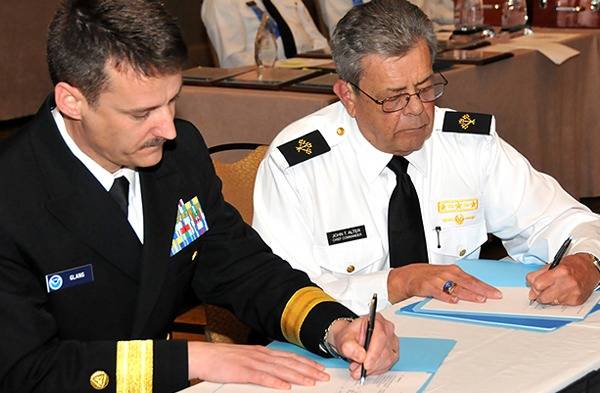
NOAA’s Office of Coast Survey & US Power Squadrons sign a Memorandum of Agreement to improve cooperative charting program.
Rear Adm. Gerd Glang, director of NOAA’s Office of Coast Survey, recently sat down with John Alter, chief commander of the U.S. Power Squadrons (USPS) to sign up to a collaboration that began fifty years ago.
The USPS is a nonprofit organization dedicated to safe boating through instruction in seamanship, navigation, and related subjects. With nearly 40,000 members in more than 400 squadrons across the U.S. and its territories, the USPS helps NOAA by keeping its members’ many watchful eyes focused on the nation’s coasts and waterways.
Under the voluntary cooperative charting program, USPS members scan both the water and the land and make note of changing conditions that may not be reflected on NOAA nautical charts. They then submit their reports online, so that NOAA cartographers can review and, if appropriate, incorporate the changes into navigation products including charts, publications, and databases.
Back in 1963, leaders in the U.S. Coast and Geodetic Survey , one of NOAA's predecessor agencies, recognized the challenge of maintaining over 1,000 U.S. nautical charts covering 95,000 miles of coastline . Acknowledging that sparse resources made it impossible for federal surveyors to inspect charted areas with any regularity, they called on the U.S. Power Squadrons for assistance and established the cooperative charting program. Fifty years on, it continues to be mutually advantageous to navigators and chartmakers—not to mention an invaluable benefit to the nation.
“The partnership between NOAA’s Office of Coast Survey and the U.S. Power Squadrons is an extremely cost-effective method for correcting chart errors that result from constantly changing coastlines and sea floors ,” says Glang, “and it speaks to our shared vision of safety on U.S. waters.”
Alter concurs, noting that in the past 10 years, 4,000 Power Squadrons members have submitted more than 28,000 corrections to NOAA. “Members get a sense of accomplishment and pride to see their contributions reflected in the latest nautical chart updates,” he says.
In the picture: NOAA Office of Coast Survey Director Rear Adm. Gerd Glang (left) and U.S. Power Squadrons Chief Commander John Alter sign the Memorandum of Agreement.



